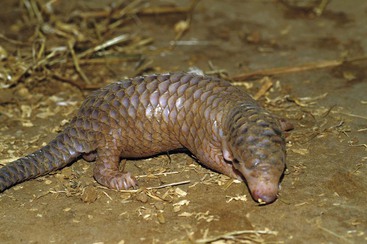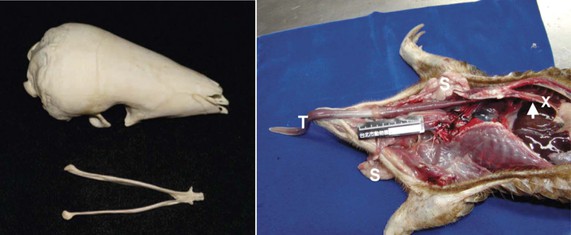Jason Shih-Chien Chin, Eric Hsienshao Tsao This small order has one extant family (Manidae) and eight species (Table 40-1). The Chinese pangolin (Manis pentadactyla), the Sunda or Malayan pangolin (M. javanica), the Philippine pangolin (M. culioensis), and the Indian or thick-tailed pangolin (M. crassicaudata) are prevalent in Asia, whereas Africa is inhabited by the Cape or Temminck’s ground pangolin (M. temminckii), the giant ground pangolin or giant pangolin (M. gigantea), the tree pangolin or African white-bellied pangolin (M. tricuspis), and the long-tailed or black-bellied pangolin (M. tetradactyla).5 The Asian species are distinguished from the African species by the presence of hair between the scales. Pangolins attain a weight of 2 to 35 kilograms (kg) (Table 40-1). Head-and-body length is 300 to 880 millimeters (mm) and tail length 350 to 880 mm.16 Males are somewhat larger than females. The dorsal surface of the elongate, tapering body is covered with scales composed of cornified epidermis, and the scales overlap in adults but not in the newborns (Figure 40-1). When in danger, pangolins are able to roll into a tight, almost impregnable ball, with only the hard, scaly parts of the body exposed. The scales are attached at the base to the thick skin from which they grow. Scales grow constantly from the base to compensate for wear. Scale pattern, size, shape and number are species characteristic and remain constant through life. The skin is sparsely haired between scales and on the abdomen. The pangolin’s tubular head has a small, toothless mouth, which contains an astoundingly long, sticky tongue. The tongue is 16 to 40 centimeters (cm) in length. In a resting state, the tongue is drawn into its sheath in the chest cavity and connecting with the inner part of xiphisternum. A pair of salivary glands extends from the ventral side of the neck almost to the shoulder. Teeth are lacking, and the lower jawbones are represented by flimsy shafts of bones (Figure 40-2). The small eyes are surrounded by thick lids that provide protection against the bites of ants and termites. All pangolins have short powerful legs with strong, curved claws. The hindlimbs are long and stouter compared with the forelimbs, and all the limbs have five digits. The central three claws of the forelimbs are much enlarged and are used for digging and breaking open ant and termite nests; they are not used as weapons. The large stomach is similar in function to the avian gizzard; it is muscular and provided with horny, laminated epithelium. The stomach of the pangolin contains a number of unique anatomic and histologic characteristics. Previous studies of the stomach of M. pentadactyla have reported the structure of the gastric gland and “pyloric teeth.”7 The stomach of pangolins is C-shaped, with short lesser curvature. At the esophageal junction, the inner smooth muscle is thickened on the greater curvature side. Instead of a mucus-secreting cellular layer, the entire luminal surface of the pangolin stomach is lined with a thick cornified, stratified squamous epithelium, except at the orifices of glands and in the pyloric gland region. The wall of the fundus is thin and devoid of glands. The gastric glands consist of mucus, oxyntic, and pyloric glands. The mucous glands are observed in the lesser curvature, in the greater curvature, and in the pyloric canal, respectively. No sphincter exists at the pyloric–duodenal junction. In the lumen of the pyloric canal region, numerous spines and small pebbles may be observed. The muscle layers in the wall of this region are considerably thickened.10 Normal droppings are black or brown in color, dry, and sausage shaped. The white-bellied tree pangolin defecates anywhere; and the Cape and Chinese pangolins bury their dung in scrapes in the ground. The pangolin anus is surrounded by a cluster of large, bean-shaped glands that secrete a noxious fluid used for defense purposes. Pangolins are largely nocturnal. Although a given species is primarily arboreal or terrestrial, none is restricted to a single plan of locomotion. Pangolins are powerful burrowers and swim adequately. They spend the day in forks or hollows in trees. Arboreal species have prehensile tails to better hold their body positions in trees. Terrestrial species dig a burrow with a terminal den, in which they pass the daylight hours and give birth. The occupant may plug the burrow entrance with dirt. When walking on all fours, the long front digging claws are curled under, and the animal walks on its knuckles. Pangolins occasionally walk on their hindlimbs, using the tail as a brace. Normally slow and deliberate, an alarmed pangolin will either make for its burrow or curl into an armor-plated ball, twitching its sharp-edged scales to ward off predators. Such a ball is almost impossible for a human to unroll. A predator successful in uncoiling a pangolin may be greeted by a pungent spray of urine or rancid fluid from the glands surrounding the anus. With their strict nocturnal activity pattern, pangolins never leave the nest box before 4 p.m. in zoologic exhibitions. Over a 10- to 11-hour period, the animals emerge and return to the nest box intermittently, and their active period ends by 02:00 a.m. The length of time when a pangolin remains outside the nest box varies from 30 seconds to 1.5 hours. individual differences exist in the total amount of time spent out of the nest box on any given night. The percentage of the 24-hour day spent outside the nest box averages 5.6% with a range of 2.9% to 7.6%. While in the nest box, pangolins are either coiled as individuals or curled up around each other to sleep. This may provide an important thermoregulatory function to reduce the area of exposed surface per unit body mass and thereby conserve heat. No aggressive behavior has ever been observed in pangolins.6 The oldest specimen recorded in captivity is a confiscated male Chinese pangolin, which lived up to 20 years in the Ueno Zoo. Over 70% rescued sick pangolins did not survive their first year in captivity, but the average has been increasing from less than 90 days to more than 1 year.18 From 2005 to date, 10 pangolins have survived over 5 years and still live well in the Taipei Zoo. One of the Chinese pangolins born in captivity at the Taipei Zoo in 1998 has survived for over 14 years now. According to the long-term case studies on maintaining Chinese pangolins, indoor pens measured 120 × 120 × 80 square centimeters (cm3) and filled to a depth of 10 cm, with a mixture of sterilized dirt and wood shavings as substrate, have been recommended for each pangolin in captivity. A wooden nest box (40 × 60 × 50 cm3) divided into two compartments, with similar mixture of dirt and wood shavings substrate for bedding, is placed in each indoor pen.3 Room temperature is controlled so as to not exceed 28° C (82° F) in the summer and to range between 24° C and 26° C (75 ° F–79° F) in the winter. Humidity is maintained at 80% to 100% and photoperiod at 10 hours per day with artificial light year round.4 The enclosure with regulated temperature (26° C) and photoperiod (10–12 hours light) is important in spatial and thermal environment. When defecating and urinating, pangolins prefer to stand in corners on their hindlimbs, with their forelimbs against the wall. The nest box is used solely for sleeping and therefore must be a relatively clean, easily maintainable enclosure.6 In the wild, pangolins live on a diet of ants, termites, and various other invertebrates, including bee larvae, flies, worms, earthworms, and crickets, which may be quite difficult for zoos to provide in sufficient quantities. Pangolins in South Africa were reported to feed on 15 species of ants and 5 termite species, with no apparent preferences. All species of pangolins are thought to feed almost entirely on ants and termites. Different species of pangolins have different preferences for various prey species of ants and termites, which are located by scent. A giant pangolin was reported to have 2 liters (L) of 11 species of ants in its stomach. Other pangolins are said to be less catholic. A white-bellied tree pangolin may eat 150 to 200 grams (g) of termites nightly.14 Quantities of sand and pebbles are ingested along with the insects. This material probably serves a function in the gizzardlike stomach, assisting in the crushing of the tough ant and termite exoskeletons. A Chinese pangolin was kept at Ueno Zoo, Tokyo, for over 20 years, on a mixture composed of 150 g of ground horse meat, 180 milliliters (mL) of milk, 1 raw egg yolk, 5 g of precooked cereals, 5 g of Esbilac, 1 g of calcium, and 0.2 mL of multivitamins.11 One Malayan pangolin had been kept at the San Diego Zoo on a blended mixture of 2 tablespoons of ground meat, 1 tablespoon of precooked cereal, 1 ounce (oz) of evaporated cow’s milk, 2 oz of water, Increasing the volume of high-protein insects as well as multivitamin and mineral supplements may improve the pangolin’s appetite as well as diet palatability, and the animals may become adapted to captive feeding more rapidly (Table 40-2). Since the development of a new diet in 1995, the Taipei Zoo has collected and maintained many pangolins that have lived longer and experienced fewer digestive problems.18 The addition of a small amount of soil was identified to stabilize fecal flora and helped in the formation of solid feces. Diet passage time could be prolonged from 24 to 48 hours to over 142 hours. Food digestibility was increased from 68% to 82%. The prevalence of hemorrhagic gastric ulcer and enteritis declined significantly.3 These diets may be fed by placing the mixture in a heavy, flat bowl. The animals lick the food off the bowl. This feeding technique prevents the animal from consuming bedding material or turning the bowl over. Drinking water should be constantly available. Some pangolins appear to enjoy a mud wallow or a spray from a hose. TABLE 40-2 Daily Formula for Formosan Pangolin at the Taipei Zoo * Mazuri 5MK8 Catalog #0050819, from PMI Nutrition International, LLC (Land O’Lakes Purina Feed, LLC), USA.
Pholidota
Introduction and Identification
Biologic Data
Anatomy
Behavior
Husbandry
Housing
Feeding and Nutrition
 of a raw egg yolk,
of a raw egg yolk,  if a teaspoon of brewer’s yeast, and 4 meal worms. Four tablespoons were fed twice daily, with the addition of 2 drops of liquid multivitamins in the morning feed.18
if a teaspoon of brewer’s yeast, and 4 meal worms. Four tablespoons were fed twice daily, with the addition of 2 drops of liquid multivitamins in the morning feed.18
Feed
Unit
Amount
Bee larvae
Gram (g)
100
Apple
g
65
Mealworms
g
22.5
Mazuri Insectivore Diet*
g
7.5
Egg yolk
g
10
Mix powder†
g
5–10
Vitamin and mineral supplement‡
g
1.5
Chitin
g
10
Water
Milliliter (mL)
60
Vitamin K
g
1/15
Soil
g
5
![]()
Stay updated, free articles. Join our Telegram channel

Full access? Get Clinical Tree


Pholidota
Chapter 40



